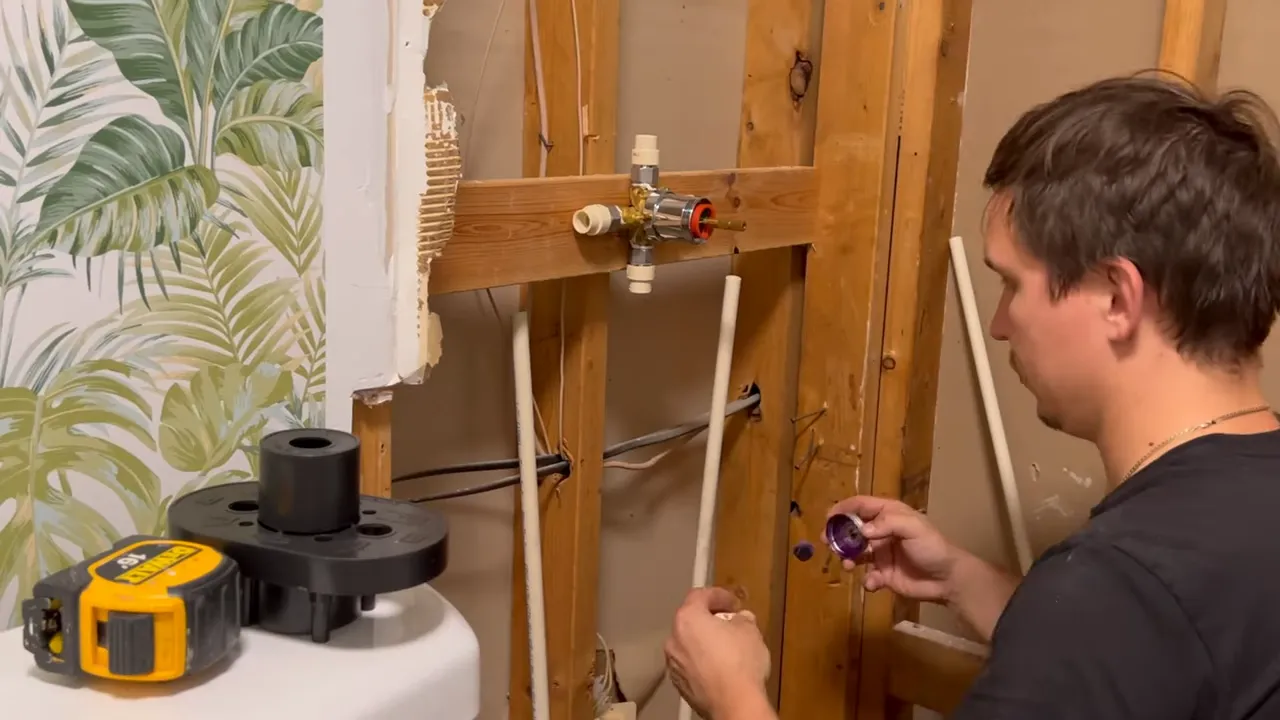To install a tub and shower faucet, begin by shutting off the water supply and removing the old faucet. Then, follow the manufacturer’s instructions to attach and secure the new faucet.
Finally, turn the water supply back on to test the installation. Introducing a new tub and shower faucet can be a challenging but rewarding task. Whether you’re replacing an old faucet or installing a brand new one, taking the time to do it properly will ensure a functional and stylish fixture in your bathroom.
This guide will walk you through the steps of installing a tub and shower faucet, from removing the old faucet to securing the new one and testing the water supply. By following these instructions and the manufacturer’s guidelines, you’ll have a beautiful and fully functional tub and shower faucet in no time.
Tools And Materials Needed
When it comes to installing a tub and shower faucet, having the right tools and materials is crucial for a successful and hassle-free installation process. In this section, we will discuss the essential tools and materials you will need, where you can purchase them, and how to ensure your installation goes smoothly.
List of tools required for installation
Before you embark on your tub and shower faucet installation journey, make sure to have the following tools at your disposal:
- Adjustable wrench
- Plumber’s putty or silicone caulk
- Plumber’s tape
- Pipe cutter or hacksaw
- Phillips screwdriver
- Flathead screwdriver
- Allen wrench
- Channel locks
- Tub and shower multi-tool
With these tools in hand, you will be well-prepared to tackle any challenges that may arise during the installation process.
List of materials required for installation
In addition to the necessary tools, you will also need a set of materials to complete your tub and shower faucet installation. These materials include:
- Tub and shower faucet set
- Plumbing hardware
- Waterproofing membrane
- Pipe fittings
- Pipe elbows and connectors
- Escutcheon plate
- Decorative trim plate
- Showerhead and tub spout
- Hot and cold water supply lines
Having these materials readily available will ensure a smooth and efficient installation process, while also guaranteeing the durability and functionality of your tub and shower faucet.
Where to purchase these tools and materials
If you are wondering where you can purchase all the necessary tools and materials for your tub and shower faucet installation, there are a few options available to you. Firstly, you can visit your local hardware or plumbing supply store. These stores usually carry a wide range of plumbing tools and materials specifically designed for this type of installation. You can also check online retailers, such as Amazon or Home Depot, which offer a wide selection of tub and shower faucet sets and related accessories. Before making a purchase, make sure to read customer reviews and compare prices to ensure you are getting the best quality products at the most affordable prices.
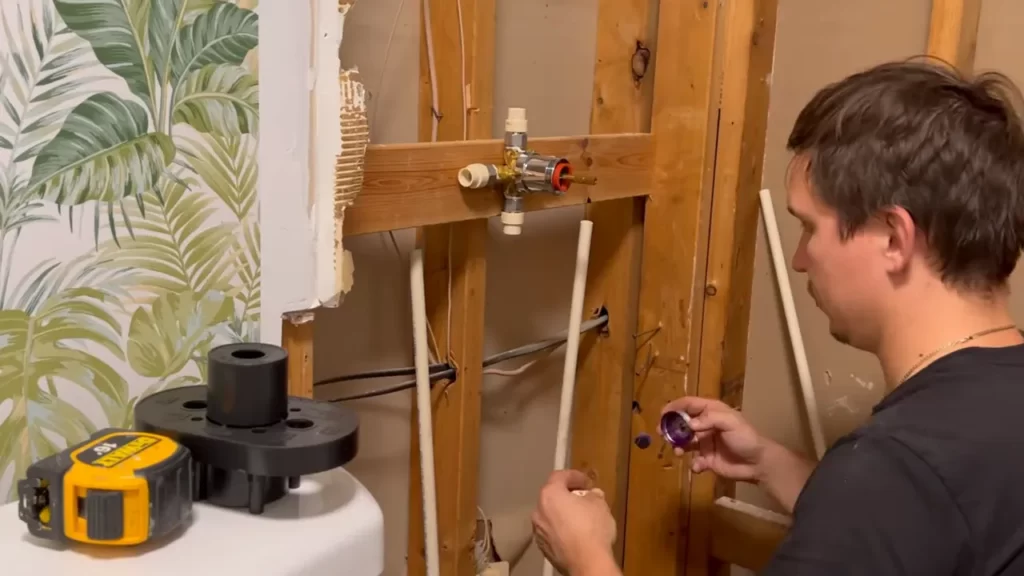
Preparing For Installation
Before you begin installing your tub and shower faucet, it’s essential to properly prepare for the installation process. This involves turning off the water supply, removing the old faucet, and inspecting and preparing the water pipes for installation. Following these steps ensures a smooth and successful installation of your new faucet. Let’s dive into the details of each step:
Turning off the water supply
The first step in preparing for the installation of your tub and shower faucet is to turn off the water supply. This prevents any water from running while you work, reducing the risk of leaks or accidents. Locate the main water supply valve in your home, usually found in the basement or utility room. Turn it clockwise until it is completely closed. Remember, safety is paramount, so take caution and wear protective gloves if necessary.
Removing the old faucet
Once the water supply is turned off, you can proceed to remove the old tub and shower faucet. Start by locating the access panel behind the shower wall or underneath the tub, which provides access to the plumbing connections. Use a screwdriver or a wrench to disconnect the hot and cold water supply lines. Next, remove the screws or nuts that secure the faucet to the wall or tub. Carefully pull out the old faucet, ensuring not to damage any surrounding fixtures or surfaces.
Inspecting and preparing the water pipes for installation
With the old faucet removed, take the opportunity to inspect the water pipes and ensure they are in good condition. Look for signs of corrosion, leaks, or any damage that may affect the proper functioning of your new tub and shower faucet. If any issues are detected, it’s crucial to address them before proceeding with the installation. Clean the pipes and surrounding area, removing any debris that may have accumulated over time.
Now that you have inspected the water pipes, it’s time to prepare them for the installation of the new faucet. Measure the distance between the pipes to ensure compatibility with your new faucet model. Gather any necessary adapters or connectors to facilitate a proper fit. Additionally, ensure that the threads on the pipe ends are clean and undamaged, as this will ensure a secure and watertight connection.
By following these steps to prepare for the installation of your tub and shower faucet, you are setting the foundation for a successful and hassle-free process. Remember to always consult the manufacturer’s instructions for your specific faucet model and take your time to complete each step with care. Soon enough, you’ll have a shiny new faucet installed, ready to enhance your bathing experience.
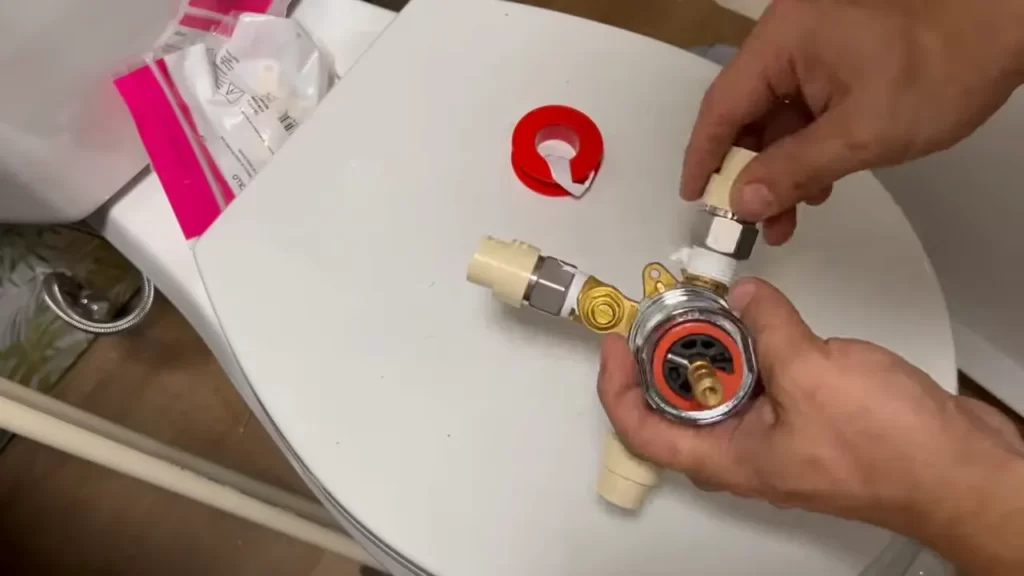
Installing The Tub And Shower Faucet
Installing a tub and shower faucet can be a daunting task, but with the right tools and a little guidance, you can do it yourself. In this section, we will walk you through the step-by-step process of positioning the faucet on the wall, connecting it to the water pipes, sealing and securing it to prevent leaks, and installing any additional features or accessories.
Positioning the faucet on the wall
The first step in installing a tub and shower faucet is to position it on the wall. Start by locating the desired height for your faucet, keeping in mind the comfort and convenience of the users. Use a level to ensure that the faucet is perfectly straight. Once you have determined the position, mark it on the wall using a pencil or tape. Now, it’s time to move on to the next step.
Connecting the faucet to the water pipes
Once you have positioned the faucet on the wall, it’s time to connect it to the water pipes. Start by turning off the water supply to the bathroom to prevent any accidents. Next, remove the old faucet, if there is one, and clean the area to ensure a proper seal. Now, it’s time to connect the faucet to the water pipes. Use the provided instructions and the correct tools to ensure a secure connection. Tighten the fittings carefully, making sure not to over-tighten, as it can cause damage.
Sealing and securing the faucet to prevent leaks
To prevent any leaks, it’s crucial to properly seal and secure the faucet. Apply plumber’s tape to the threaded fittings of the water pipes before attaching the faucet. This tape helps create a watertight seal and prevents leaks. Once you have securely attached the faucet, check for any visible gaps or cracks. If you notice any, use caulking to seal them. Finally, turn on the water supply and test for any leaks. If everything looks good, move on to the final step.
Installing any additional features or accessories
To enhance your showering experience, you may want to install additional features or accessories with your tub and shower faucet. This could include a showerhead, a hand-held shower wand, or a diverter valve for added functionality. Follow the manufacturer’s instructions to properly install these additional features. Ensure that they are securely attached and don’t forget to test for any leaks before enjoying your new tub and shower faucet.
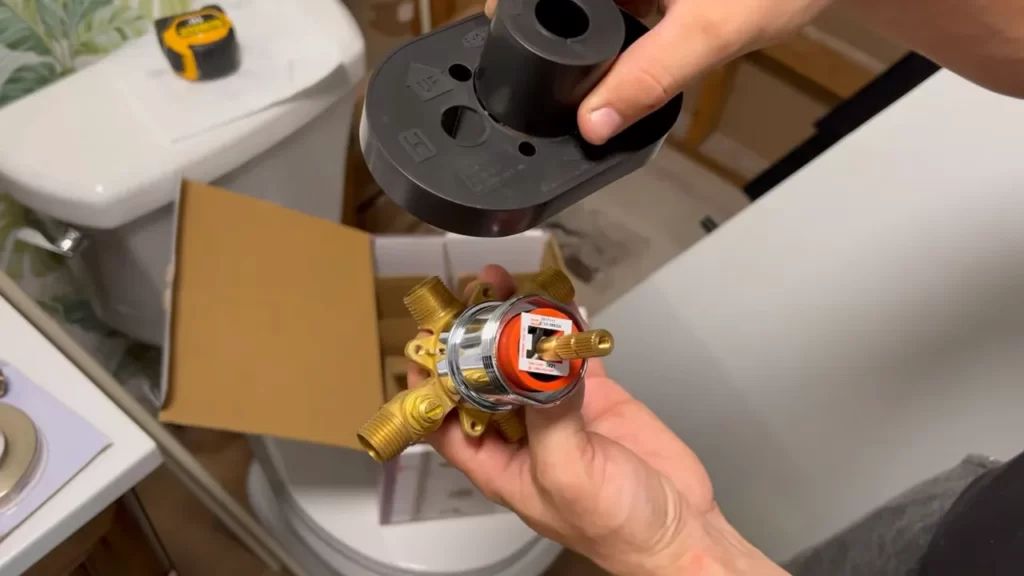
Testing And Adjusting The Faucet
After installing your tub and shower faucet, it is crucial to test and adjust it to ensure proper functionality and prevent any leaks or drips. In this section, we will walk you through the necessary steps to test and adjust your faucet, including turning on the water supply, checking for leaks and drips, adjusting the water temperature and pressure, and ensuring the proper functionality of all faucet components.
Turning on the water supply
Now that you have successfully installed your tub and shower faucet, it’s time to turn on the water supply. Follow these steps to ensure a smooth flow of water:
- Locate the water supply valve near your tub and shower area.
- Turn the valve clockwise to open it and allow water to flow through the pipes.
- Check for any leaks around the valve or pipes.
Once you have turned on the water supply, it’s time to move on to the next step: checking for leaks and drips.
Checking for leaks and drips
Ensuring that your tub and shower faucet is leak-proof is essential for its longevity and functionality. Follow these steps to thoroughly check for leaks and drips:
- Inspect the faucet connections and fittings for any visible signs of leaks.
- Turn on the faucet and let the water flow.
- Check around the faucet handles, spout, and showerhead for any water leakage or dripping.
- If you notice any leaks or drips, tighten the connections or replace any faulty parts.
Now that you have checked for leaks and drips, it’s time to move on to adjusting the water temperature and pressure.
Adjusting the water temperature and pressure
Properly adjusting the water temperature and pressure is essential for a comfortable and enjoyable bathing experience. Follow these steps to adjust the water temperature and pressure:
- Turn on the hot and cold water valves.
- Gradually adjust the temperature by turning the hot and cold water handles.
- Test the water temperature by placing your hand under the running water.
- Adjust the pressure by turning the water handle or using the pressure regulator, if available.
- Check that the water temperature and pressure are at your desired level.
Now that you have adjusted the water temperature and pressure, it’s time to ensure the proper functionality of all faucet components.
Ensuring proper functionality of all faucet components
Lastly, it’s crucial to ensure that all the components of your tub and shower faucet are functioning correctly. Follow these steps to ensure proper functionality:
- Test each faucet handle to ensure they turn on and off smoothly.
- Turn on the showerhead and check for proper water flow and spray pattern.
- Test any additional features, such as a hand shower or body jets, if applicable.
- Inspect the drain system to ensure proper draining without any leaks.
- If you notice any issues with the faucet components, make the necessary adjustments or consult a professional plumber.
By following these steps, you can test and adjust your tub and shower faucet to ensure its proper functionality and prevent any leaks or drips. Enjoy a relaxing and refreshing bathing experience with your newly installed faucet!
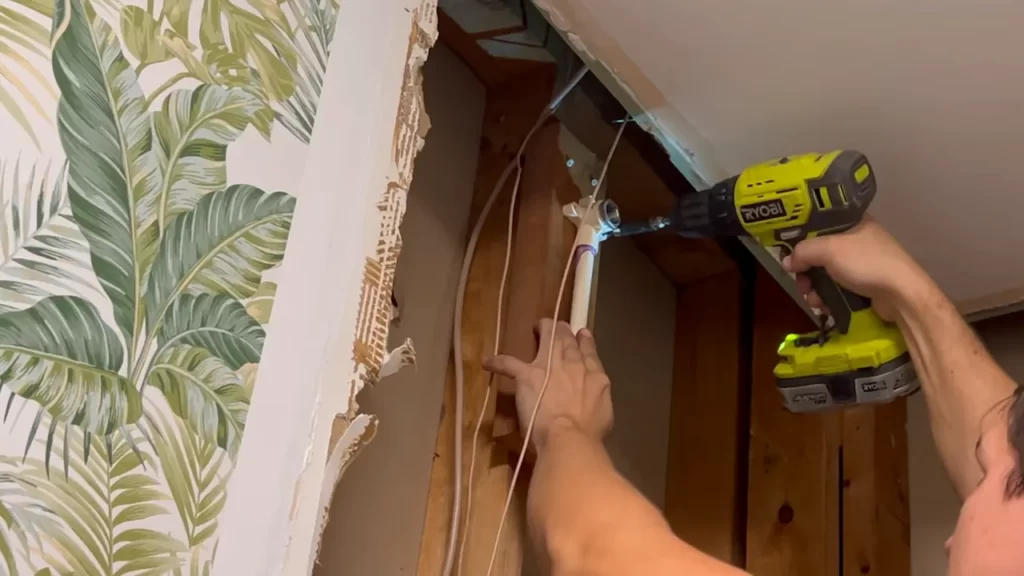
Cleaning Up And Maintenance
Now that you have successfully installed your tub and shower faucet, it is important to understand the significance of proper cleaning up and maintenance. This will not only keep your faucet looking sparkling new but also ensure its longevity and prevent any potential issues in the future.
Cleaning and wiping down the installed faucet
Regular cleaning and wiping down of the installed faucet is essential to remove any dirt, grime, or soap residue that may accumulate over time. This will not only maintain its aesthetic appeal but also prevent the growth of any harmful bacteria. Follow these simple steps to keep your faucet shining like new:
- Start by wiping the surface of the faucet with a soft cloth or sponge dampened with warm water. This will help remove any loose dirt or debris.
- Mix a solution of mild liquid soap and warm water in a small bowl. Dip a clean cloth or sponge into the soapy water and gently scrub the faucet, paying extra attention to the hard-to-reach areas.
- Rinse the faucet thoroughly with warm water to remove any soap residue.
- Finally, dry the faucet with a clean, dry cloth to prevent water spots or streaks.
By incorporating this simple cleaning routine into your regular bathroom cleaning schedule, you can ensure that your tub and shower faucet remains spotless and free from any unsightly buildup.
Maintaining the faucet to prevent future issues
To prevent any potential issues and extend the lifespan of your tub and shower faucet, proper maintenance is key. Here are some essential maintenance tips to keep in mind:
- Inspect the faucet regularly for any signs of leakage, cracks, or loose parts. If you notice any issues, address them promptly to avoid further damage.
- Check the faucet’s aerator for any mineral buildup. If necessary, remove the aerator and clean it with a solution of vinegar and water to remove any hard water deposits.
- Ensure that the handles and knobs are tightened properly to prevent any wobbling or loosening over time.
- Keep the surrounding area of the faucet dry and clean to prevent moisture buildup and the growth of mold or mildew.
- If your faucet has a diverter, test it regularly to ensure smooth water flow between the tub and shower functions.
By following these maintenance practices, you can enjoy a well-functioning and reliable tub and shower faucet for years to come.
Troubleshooting common problems and solutions
Even with regular maintenance, occasional issues may arise with your tub and shower faucet. Here are some common problems you might encounter and their possible solutions:
| Problem | Solution |
|---|---|
| Dripping faucet | Replace the worn-out cartridge or rubber O-rings inside the faucet to stop the dripping. |
| Low water pressure | Check for any clogs or mineral buildup in the aerator or showerhead. Clean or replace them if necessary. |
| Uneven water temperature | Adjust the temperature limiter or thermostatic valve to ensure a consistent and comfortable water temperature. |
| Strange noises | Flush out any air or debris trapped in the pipes by turning the faucet on and off a few times. |
Remember, if you encounter any major issues or are unsure about how to handle a specific problem, it is always best to consult a professional plumber for assistance. They have the expertise to diagnose and fix any complex faucet issues with precision.
By following these cleaning, maintenance, and troubleshooting tips, you can enjoy a clean, functional, and problem-free tub and shower faucet for years to come!
Tips And Tricks For A Successful Installation
Tips and Tricks for a Successful Installation
Installing a tub and shower faucet may seem like a daunting task, but with the right tips and tricks, it can be a smooth and successful process. By following some simple guidelines, avoiding common mistakes, and ensuring safety, you can install your tub and shower faucet with confidence. In this article, we will discuss some helpful tips and tricks for a successful installation.
Avoiding common mistakes during installation
When it comes to installing a tub and shower faucet, there are some common mistakes that many people make. By being aware of these mistakes and taking steps to avoid them, you can save yourself time and frustration. Here are a few common mistakes to watch out for:
- Failure to properly shut off the water supply before beginning the installation can lead to leaks and potential damage. Always turn off the water at the main shut-off valve before starting the installation process.
- Incorrectly measuring and aligning the faucet can result in a crooked or uneven installation. Take the time to measure and mark the correct placement of the faucet to ensure a professional-looking finish.
- Using the wrong tools or not having the necessary supplies on hand can cause delays and make the installation more difficult. Make sure you have all the required tools and materials before you start the installation.
Helpful tips for overcoming challenges
During the installation process, you may encounter some challenges that require creative solutions. Here are a few helpful tips to overcome these challenges:
- If you encounter a stubborn old faucet that is difficult to remove, applying heat using a hairdryer can help loosen it. Be sure to protect yourself and the surrounding area from heat damage, and use caution when working with hot surfaces.
- If you need to make adjustments to the plumbing connections, using flexible hoses or extension pipes can make the process easier. These flexible components allow for more flexibility and adaptability during installation.
- If the wall behind the tub and shower faucet is not level, using shims can help level the faucet. Place the shims between the wall and the faucet to ensure a straight and secure installation.
Ensuring safety while installing the faucet
Safety should be a top priority when installing a tub and shower faucet. Here are a few key points to keep in mind to ensure a safe installation:
- Always wear safety goggles and gloves when working with tools and plumbing materials to protect your eyes and hands from injury.
- If you are unsure about any aspect of the installation, consult a professional plumber to ensure the job is done correctly and safely.
- Avoid over-tightening the connections, as this can lead to leaks and damage. Use proper torque and follow manufacturer’s instructions for tightening the faucet components.
By following these tips and tricks, you can have a successful tub and shower faucet installation. Remember to take your time, use the correct tools and materials, and prioritize safety throughout the process. With a little patience and attention to detail, you’ll have a fully functional and beautiful tub and shower faucet in no time.
Frequently Asked Questions
How Much Does It Cost To Install A Shower And Tub Faucet?
The cost to install a shower and tub faucet varies depending on factors such as the type of faucet and labor fees. On average, homeowners can expect to pay between $150 and $600 for installation. Keep in mind that prices may differ based on location and the complexity of the project.
Can You Install A Tub And Shower Faucet For Shower Only?
Yes, you can install a tub and shower faucet for a shower-only setup.
How Do You Connect A Bathtub To A Shower?
To connect a bathtub to a shower, you’ll need to install a diverter valve that directs water to either the tub or the showerhead. Attach the showerhead to the diverter valve outlet and connect the valve to the existing plumbing.
Then, simply switch the diverter valve to choose between bath or shower.
How Do You Attach A Shower Head To A Bathtub Faucet?
To attach a shower head to a bathtub faucet, you can use a diverter valve. First, unscrew the existing shower head from the pipe. Then, install the diverter valve by screwing it onto the pipe. Finally, attach the shower head to the other end of the diverter valve.
Enjoy your shower!
Conclusion
Installing a tub and shower faucet may seem daunting at first, but with the right tools and steps, it can be a straightforward process. By following the guidelines outlined you will be able to successfully install your tub and shower faucet, adding functionality and style to your bathroom.
Remember to always refer to the manufacturer’s instructions and seek professional help if needed. Enjoy your new tub and shower faucet!
